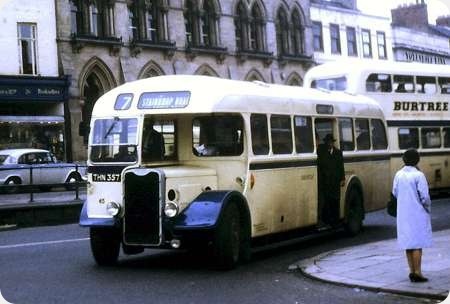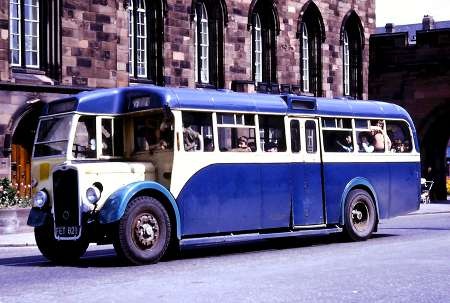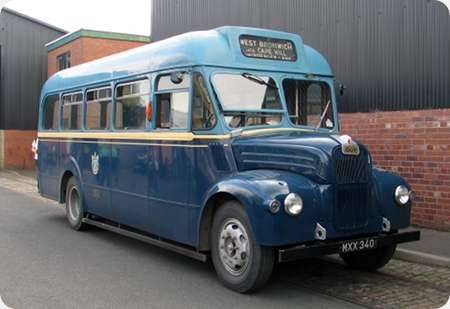
County Borough of Darlington Transport Department
1953
Guy Arab III 5LW
Roe B41C
The small operation of Darlington Corporation does not seem to be mentioned on the Website.
I have only been to the town once back in 1968. I took just one photo probably as it was unusual even in those days to see a passenger ready to leave the centre entrance whilst the bus was still in motion. A single deck Guy Arab III was also unusual for me.
I have recently rediscovered this old slide taken with a very basic camera, I hope it may be of interest.
Photograph and Copy contributed by Keith Newton
13/08/15 – 08:15
I don’t think the Roe West Riding Red AEC’s had doors to their centre entrances, either. This made the rear saloon a chilly place- and as you suggest the elfansafety doesn’t bear thinking about- the step backwards system of alighting from a moving bus platform was impossible and twisting sideways must have been just right to fall against the rear wheels. End of an era, here.
Joe
13/08/15 – 08:51

I attach a bought slide of a Swindon Daimler CV single decker with a similar centre entrance/exit arrangement. How popular was it, exactly? I know some of Blackpool ones in the 1930s, and we all know about their PD2/5 fleet, but single deckers like this seem very rare.
Pete Davies
13/08/15 – 11:53
Not centre-entrance and a decker, but London Transport’s Country Area STL’s posed the same hazards as the other two vehicles. LPTB’s 1936 (ex-STL 1470) offering was lauded by them as ‘draught-free’, a statement, from personal experience, I heartily disagreed with, despite the angled front bulkhead and rear partition to entrance! Note the staircase opposite the entrance. LINK: www.flickr.com/photos/
Chris Hebbron
13/08/15 – 13:55
Joe, I think the West Riding centre-entrance Regents had doors. However, like you, I also remember being cold in their rear saloons so they probably spent most of their time open (to save the conductors’ time).
This photo seems to show the door in a closed position. //www.bus-and-coach-photos.com/picture/number5402.asp Some photos suggest they were double doors, hinged outwardly opening. If only 111 had survived beyond early preservation.
Paul Haywood
13/08/15 – 14:40
Municipal conservatism at work with these Guys? By 1953 underfloor engined saloons were well established and virtually the norm so these purchases seem a bit of an anachronism. Doncaster and Burnley, Colne and Nelson were other operators that stuck to half-cab single deckers well into the 1950’s with BCN taking PS2 Tigers right up to 1955. More examples of those little things that make our hobby so interesting.
Philip Halstead
14/08/15 – 11:51
Hunter of Seaton Delaval had two TS7 Leyland Tigers, JR 4901, from 1935, and JR 6600, 1936: both Burlingham B35F. In 1953 and 54 respectively, they were rebodied by Roe as B39C, they were very similar to this Darlington example, but differed slightly in that they had doors which were flush with the side of the bus when shut, but I cant for the life of me remember if they were two single doors, or a two piece folding type. The only thing that let them down, was that they had been rebodied as 8ft on a 7’6" chassis, which tended to make them look a bit unbalanced.
Ronnie Hoye
16/08/15 – 06:35
Must have been a job keeping them clean,,,,
Mike
16/08/15 – 06:36
The last conventional half-cab saloons (both complete buses and new bodies for old chassis) date from 1955, after which only a few specialised vehicles were built on chassis normally bodied as double-deckers – a Leyland PD2 for West Mon, eight Regent Vs for South Wales Transport and two more as non-PSVs registered in Leeds.
Geoff Kerr
01/09/15 – 07:43

Rotherham Corporation ran a large fleet of Bristol L5G and L6B buses mostly with central entrance. FET 821 f/n 121 was one of the last delivered in 1951 with an East Lancs body and makes an interesting contrast to the standard ECW bodies which never -to my knowledge – offered this option. It was photographed in 1970 in Carlisle clearly on a school outing but from where and who was the operator- perhaps owned by the school itself?
Keith Newton
02/09/15 – 07:02
Keith, thanks for John Kaye who gave me this information regarding Rotherham 121 (above).
It was withdrawn by Rotherham in September 1968 it is recorded with Army Cadet Force, Dearne Valley Area, Wath (later Wakefield) in January 1969 and sold for scrap 1970.
Paul Haywood
02/09/15 – 07:03
This bus appeared on the SCT61 site and the discussion following the photographs gives some explanation as to why the bus would have been in Carlisle: //www.sct61.org.uk/rr121
David Beilby







